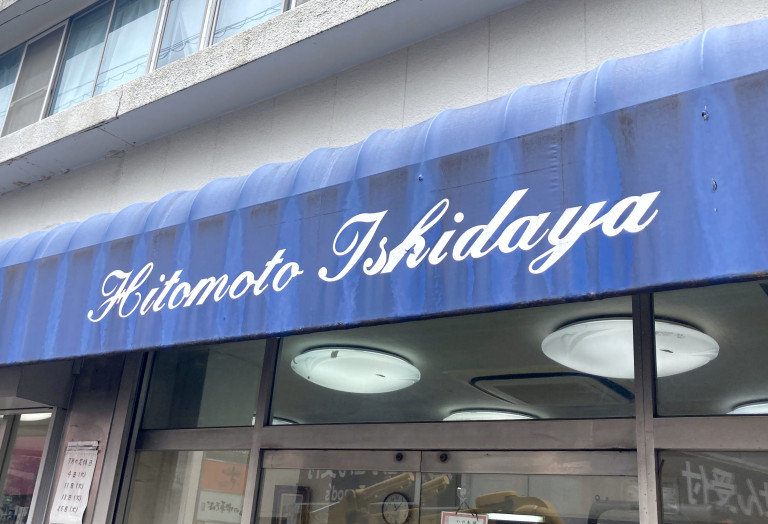
Turns out there’s a reason why this shop always has lines of customers!
When you live in Tokyo, or live in an area outside of the city and commute in, you get used to the train lines you’re always riding, which stations your train stops at and what kind of things can be found along the way. It also means that, since you’re mostly only ever taking that train, you don’t know anything about areas beyond that line.
For our own Japanese-language reporter Mr. Sato, that means he’s pretty much unfamiliar with Tokyo outside the major neighborhoods and the stations along the Chuo Line, which stretches out from Shinjuku to the northwestern fringes of the city. So when he happened to be visiting Kami-Itabashi Station on the Tobu Toju Line, north of the city center, he decided to take the opportunity to look around.
That’s when he spotted Hitomoto Ishidaya, a busy shop that had a never-ending stream of customers going in and out. Upon closer inspection, he learned it’s an old dessert shop that serves both Japanese and Western-style pastries and sweets, but such shops are a dime a dozen in Tokyo. What’s so special about this one? Naturally, he had to find out.
Hitomoto Ishidaya is just a one-minute walk from the south exit of Kami-Itabashi Station. It’s located in a small shopping street, in the same building as its factory. From the outside, you can see people lining up along the showcases.
▼ The short walk from Kami-Itabashi Station to Hitomoto Ishidaya
Mr. Sato had passed the shop on the way to his errand, and on his way back, he noticed that the line had not gotten any shorter. He assumed that to mean that there’s always a line there. With some time to kill, he went for a walk around the neighborhood, but even after he made his way back to Hitomoto Ishidaya, the line hadn’t shortened at all. In fact, it had gotten longer!
Curious beyond measure, Mr. Sato checked out the reviews online, only to find that the place was very highly rated. Apparently, they have a type of dorayaki, a red bean paste sandwich using castella cakes, that they sell in limited quantities, and people line up as soon as the shop opens to buy them. They’re so sought after that they’re referred to as “Mythical Dorayaki”. Of course, by the time Mr. Sato visited, they were already sold out.
Either way, the popularity of the shop intrigued him, so, in the spirit of journalism, he hopped in the line.
As he waited his turn, he browsed the sweets on display. There were both Western and Japanese-style desserts available, but it seemed like most of the customers bought Japanese sweets. What surprised him more, though, were the prices, which were relatively cheap compared to other sweets shops. One of the “legendary” dorayaki was just 180 yen (US$1.28), Chestnut Manju were 170 yen, Madeleines were 130 yen each, and Cream Cheese Sandwich Cookies were 140 yen each. Many people were buying 10 or 20 of one sweet at a time.
Mr. Sato decided to try the Butter Manju (120 yen each), and he bought 10. Manju are popular Japanese-style stuffed sweets, similar to certain mochi desserts but made with wheat flour instead of rice flour. But Mr. Sato had never heard of a “Butter Manju”. Would it just have butter inside, instead of the traditional red bean filling? From the name, Mr. Sato would guess it was a Western-style sweet, but since it’s a manju, it also sounded Japanese. It was quite a mystery.
Each one was wrapped in wax paper, and printed on the paper was the product information. There the product was listed as “Butter Man” as if it were actually a steamed bun (“man“), which further confounded Mr. Sato’s impression.
Unwrapped, it looked like this.
The color, at least, give off a sense of “butter”. It also looked like it was topped with some kind of cream, but the product’s expiration was dated five days from then, so it couldn’t be anything super-perishable.
Things became clearer when Mr. Sato cut it in half. The top part was some kind of meringue-like sweet, and the filling was tightly packed sweet white bean paste. But where did the butter come in?
The answer to that question came from a taste test. The dough encasing the filling was packed full of buttery goodness. With each bite, the rich, sweet flavor tickled even his nose, and the crunch of the meringue on top added a delightful contrasting texture. What became even more obvious with each bite was how fine the texture of the white bean paste was; it simply melted in Mr. Sato’s mouth.
It was clear that this was a very finely crafted sweet. And each one was only 120 yen! Apparently, they sell these directly from the factory so that they can produce them without preservatives or additives, allowing the flavor of each of the ingredients to really shine. For that reason, they don’t sell them online.
These Butter Manju (or Butter Man) are simple but have a very light, delicious flavor, that you can only find at Hitomoto Ishidaya. That explains why there’s always a line there! Mr. Sato sorely hopes that such a delicious sweets shop will be around forever, and he fully plans on trying that mythical dorayaki one day.
If you’re in the neighborhood, definitely consider trying them out! Itabashi is also where Mr. Sato happened to find some really delicious bread…So it might even be worth taking a deliberate trip there.
Restaurant information
Hitomoto Ishidaya / ひと本 石田屋
Address: Tokyo-to Itabashi-ku Kami-Itabashi 2-32-16
東京都板橋区上板橋2丁目32-16
Open 8:45 a.m.-5:45 p.m.
Closed Tuesdays
Images © SoraNews24
● Want to hear about SoraNews24’s latest articles as soon as they’re published? Follow us on Facebook and Twitter!
[ Read in Japanese ]